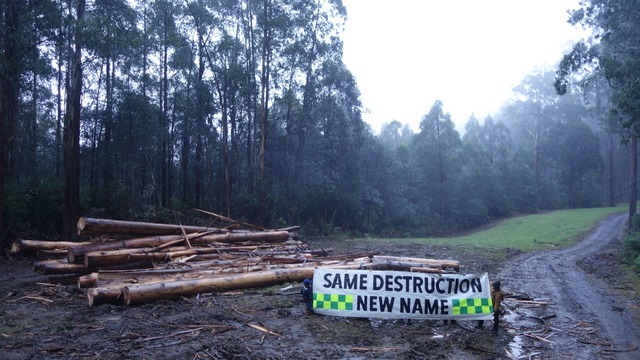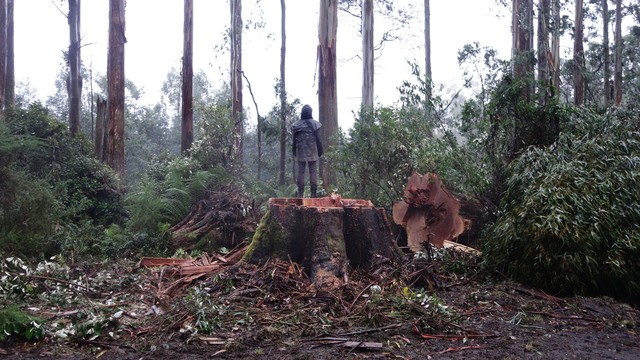By Callum Ludwig
Environmental groups are challenging Forest Fire Management Victoria (FFMVic) on its fire-reduction practices, including in the protected Yarra Ranges National Park.
Autumn is a significant time of year for FFMVic, with most planned burns, clearing efforts and other fire reduction activities carried out at this time but groups such as Warburton Environment and Forest Conservation Victoria are concerned that crews are removing significant and hollow-bearing trees.
President of the Warburton Environment group Nic Fox said they find it deplorable that living, hollow-bearing, old-growth trees can’t be protected in national parks.
“We know the Federal and State Environment Ministers released a plan last month, a Leadbeater’s Possum recovery plan, which sets out very clear requirements for the protection of large and hollow-bearing trees and that there should be no destruction of critical Leadbeater’s Possum habitat which is what we’re seeing this month,” she said.
“We’re bearing witness and documenting the destruction of critical habitat, some of these trees are hundreds of years old and they’re being cut down.”
In the Federal Department of Climate Change, Energy, the Environment and Water (DCCEEW)’s National Recovery Plan for Leadbeater’s Possum announced on 5 March, the Threatened Species Scientific Committee (TSSC) used hollow-bearing trees as an indicator of the abundance of Leadbeater’s possum as they are the most limiting resource required by the species, take the longest to regrow or be replaced and any current or future decline in hollow-bearing trees would result in a decline in the population of the possum.
The decline in hollow-bearing trees has been attributed to the collapse of dead- hollow-bearing trees burned in the 1939 fires, the reduction in the extent of mature ash forest or areas that will mature in the future due to historical timber harvesting and the impacts of the 2009 Black Saturday bushfire. Climate change and any future extensive bushfires are seen as the biggest threats to the trees and the Leadbeater’s Possum in the future.
Ms Fox said she thinks we need to close all the loopholes that still exist since the end of native forest logging, which began at the state of this year in Victoria.
“What we really need is an independent regulator that has the resources, authority and power to regulate what’s happening out here because the fight’s not over, the forest wars continue, it’s morphed into another beast,” she said.
“We need to look at the assessment method of what hazardous trees are, we need to look all over the planned burns and there are other groups that are more knowledgeable about that but I think the methods that have been used are outdated,”
“We need to look at the new size (of the forest since the end of naive forest logging) and we also obviously need to incorporate traditional owners.”
Forest Conservation Victoria conducted a peaceful protest in the Yarra Ranges National Park on Wednesday 24 April, with some local community members involved.
Deputy Chief Fire Officer for the Port Phillip Region Shannon Devenish said work is underway to maintain the strategic fuel break network in and around the Upper Yarra water supply catchment, including within Yarra Ranges National Park.
“Working within the footprint of existing fuel breaks, crews are treating dangerous trees and clearing encroaching vegetation,” they said.
“Trees that are structurally compromised and are a threat to firefighter safety have been marked as hazardous during an initial assessment,”
FFFMVic’s fire-reduction works are also intended to help firefighters protect the state’s water supply, with the Yarra River accounting for 70 per cent of Melbourne’s drinking water, and where silt, ash and debris during and after a bushfire can flow into reservoirs like the Upper Yarra and Maroondah Reservoirs and disrupt the water supply for an extended period of time.
Devenish said further assessments will be carried out to determine if alternative protection measures can be used to keep fire out of the trees during a bushfire event.
“These fuel breaks enable firefighters to carry out backburning in the event of a major bushfire and are a critical part of FFMVic’s strategy to protect Melbourne’s water supply and other important environmental values from bushfires,” they said.
“The Upper Yarra water supply catchment area is home to environmentally significant flora and fauna including Leadbeater’s possum, Southern Greater Glider, Smokey Mouse and Cool Temperate Rainforest, all of which are highly susceptible to large scale bushfires.”
Forest Conservation Victoria and the Friends of the Leadbeater’s Possum were contacted for comment.








